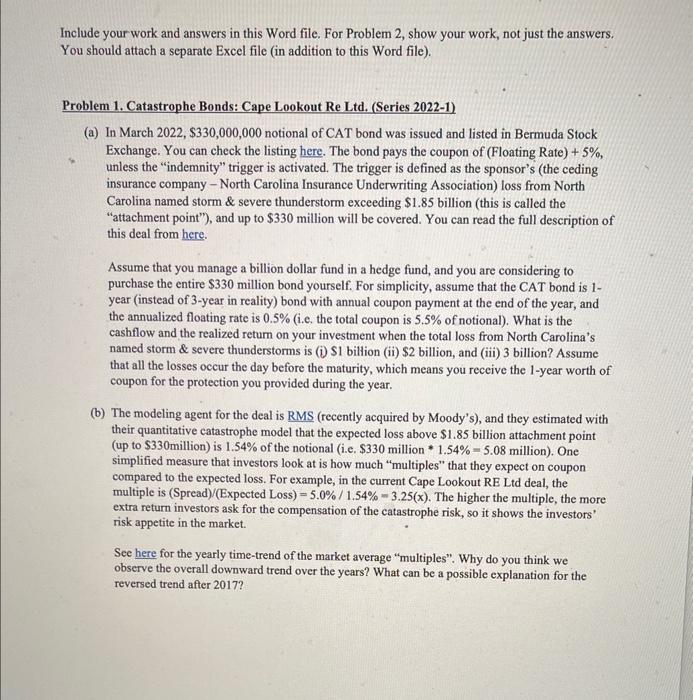Answered step by step
Verified Expert Solution
Question
1 Approved Answer
please answer in detail Include your work and answers in this Word file. For Problem 2, show your work, not just the answers. You should
please answer in detail 
Include your work and answers in this Word file. For Problem 2, show your work, not just the answers. You should attach a separate Excel file (in addition to this Word file). Problem 1. Catastrophe Bonds: Cape Lookout Re Ltd. (Series 2022-1) (a) In March 2022, $330,000,000 notional of CAT bond was issued and listed in Bermuda Stock Exchange. You can check the listing here. The bond pays the coupon of (Floating Rate) +5%, unless the "indemnity" trigger is activated. The trigger is defined as the sponsor's (the ceding insurance company - North Carolina Insurance Underwriting Association) loss from North Carolina named storm \& severe thunderstorm exceeding $1.85 billion (this is called the "attachment point"), and up to $330 million will be covered. You can read the full description of this deal from here. Assume that you manage a billion dollar fund in a hedge fund, and you are considering to purchase the entire $330 million bond yourself. For simplicity, assume that the CAT bond is 1year (instead of 3-year in reality) bond with annual coupon payment at the end of the year, and the annualized floating rate is 0.5% (i.e. the total coupon is 5.5% of notional). What is the cashflow and the realized retum on your investment when the total loss from North Carolina's named storm \& severe thunderstorms is (i) \$1 billion (ii) \$2 billion, and (iii) 3 billion? Assume that all the losses occur the day before the maturity, which means you receive the 1-year worth of coupon for the protection you provided during the year. (b) The modeling agent for the deal is RMS (recently acquired by Moody's), and they estimated with their quantitative catastrophe model that the expected loss above $1.85 billion attachment point (up to $330 million) is 1.54% of the notional (i.e. $330 million * 1.54%=5.08 million). One simplified measure that investors look at is how much "multiples" that they expect on coupon compared to the expected loss. For example, in the current Cape Lookout RE Ltd deal, the multiple is (Spread)/(Expected Loss) =5.0%/1.54%=3.25(x). The higher the multiple, the more extra return investors ask for the compensation of the catastrophe risk, so it shows the investors' risk appetite in the market. See here for the yearly time-trend of the market average "multiples". Why do you think we observe the overall downward trend over the years? What can be a possible explanation for the reversed trend after 2017? Include your work and answers in this Word file. For Problem 2, show your work, not just the answers. You should attach a separate Excel file (in addition to this Word file). Problem 1. Catastrophe Bonds: Cape Lookout Re Ltd. (Series 2022-1) (a) In March 2022, $330,000,000 notional of CAT bond was issued and listed in Bermuda Stock Exchange. You can check the listing here. The bond pays the coupon of (Floating Rate) +5%, unless the "indemnity" trigger is activated. The trigger is defined as the sponsor's (the ceding insurance company - North Carolina Insurance Underwriting Association) loss from North Carolina named storm \& severe thunderstorm exceeding $1.85 billion (this is called the "attachment point"), and up to $330 million will be covered. You can read the full description of this deal from here. Assume that you manage a billion dollar fund in a hedge fund, and you are considering to purchase the entire $330 million bond yourself. For simplicity, assume that the CAT bond is 1year (instead of 3-year in reality) bond with annual coupon payment at the end of the year, and the annualized floating rate is 0.5% (i.e. the total coupon is 5.5% of notional). What is the cashflow and the realized retum on your investment when the total loss from North Carolina's named storm \& severe thunderstorms is (i) \$1 billion (ii) \$2 billion, and (iii) 3 billion? Assume that all the losses occur the day before the maturity, which means you receive the 1-year worth of coupon for the protection you provided during the year. (b) The modeling agent for the deal is RMS (recently acquired by Moody's), and they estimated with their quantitative catastrophe model that the expected loss above $1.85 billion attachment point (up to $330 million) is 1.54% of the notional (i.e. $330 million * 1.54%=5.08 million). One simplified measure that investors look at is how much "multiples" that they expect on coupon compared to the expected loss. For example, in the current Cape Lookout RE Ltd deal, the multiple is (Spread)/(Expected Loss) =5.0%/1.54%=3.25(x). The higher the multiple, the more extra return investors ask for the compensation of the catastrophe risk, so it shows the investors' risk appetite in the market. See here for the yearly time-trend of the market average "multiples". Why do you think we observe the overall downward trend over the years? What can be a possible explanation for the reversed trend after 2017 
Step by Step Solution
There are 3 Steps involved in it
Step: 1

Get Instant Access to Expert-Tailored Solutions
See step-by-step solutions with expert insights and AI powered tools for academic success
Step: 2

Step: 3

Ace Your Homework with AI
Get the answers you need in no time with our AI-driven, step-by-step assistance
Get Started


